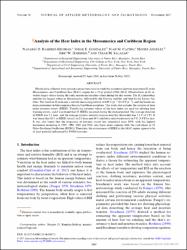Mostrar el registro sencillo del ítem
Analysis of the heat index in the Mesoamerica and Caribbean region
| Licencia | Creative Commons Attribution License (CC BY). The use, distribution or reproduction in other forums is permitted, provided the original author(s) and the copyright owner(s) are credited and that the original publication in this journal is cited, in accordance with accepted academic practice. No use, distribution or reproduction is permitted which does not comply with these terms. | es |
| Autor | Ramírez-Beltrán, Nazario D. | |
| Autor | González, Jorge E. | |
| Autor | Castro, Joan M. | |
| Autor | Ángeles, Moisés | |
| Autor | Harmsen, Eric W. | |
| Autor | Salazar, César M. | |
| Fecha de admisión | 2022-06-01T23:01:28Z | |
| Fecha disponible | 2022-06-01T23:01:28Z | |
| Año | 2017 | |
| Citación | Ramírez-Beltrán, N. D., González, J. E., Castro, J. M., Ángeles, M., Harmsen, E. W., & Salazar, C. M. (2017). Analysis of the heat index in the mesoamerica and caribbean region. Journal of Applied Meteorology and Climatology, 56(11), 2905-2925. Recuperado de: | es |
| URI | https://bvearmb.do/handle/123456789/1020 | |
| Sinopsis | Hourly data collected from ground stations were used to study the maximum daytime heat index Hi in the Mesoamerica and Caribbean Sea (MAC) region for a 35-yr period (1980–2014). Observations of Hi revealed larger values during the rainy season and smaller values during the dry season. The Hi climatology exhibits the largest values in Mesoamerica, followed by the Greater Antilles and then by the Lesser Antilles. The trend in Hi indicates a notable increasing pattern of 0.05°C yr−1 (0.10°F yr−1), and the trends are more prominent in Mesoamerica than in Caribbean countries. This work also includes the analysis of heat index extreme events (HIEE). Usually the extreme values of the heat index are used for advising heat warning events, and it was found that 45 HIEEs occurred during the studied period. The average duration of HIEE was 2.4 days, and the average relative intensity (excess over the threshold) was 2.4°C (4.3°F). It was found that 82% of HIEE lasted 2 or 2.5 days and 80% exhibited relative intensity of 3°C (5.4°F) or less. It was also found that the frequency of extreme events has intensified since 1991, with the highest incidences occurring in 1995, 1998, 2005 and 2010, and these years coincide with the cool phase of El Niño–Southern Oscillation (ENSO). Therefore, the occurrences of HIEE in the MAC region appear to be at least partially influenced by ENSO episodes. | es |
| Idioma | English | es |
| Publicado | Journal of Applied Meteorology and Climatology, 56(11), 2905-2925. | es |
| Derechos | © 2017 American Meteorological Society. | es |
| URI de derechos | https://creativecommons.org/licenses/by/4.0/ | es |
| Título | Analysis of the heat index in the Mesoamerica and Caribbean region | es |
| Tipo de material | Article | es |
| Tipo de contenido | Scientific research | es |
| Acceso | Open | es |
| Audiencia | Technicians, professionals and scientists | es |
Ficheros en el ítem
Este ítem aparece en la(s) siguiente(s) colección(es)
-
Investigación ambiental [1188]
La consulta y descarga de este documento están sujetas a esta licencia: Creative Commons Attribution License (CC BY). The use, distribution or reproduction in other forums is permitted, provided the original author(s) and the copyright owner(s) are credited and that the original publication in this journal is cited, in accordance with accepted academic practice. No use, distribution or reproduction is permitted which does not comply with these terms.
© 2017 American Meteorological Society.
© 2017 American Meteorological Society.


